Safe Robotics in Human-Shared Environments: Embedded Sensing and Compliance

The robotics industry has entered a new phase where robots no longer work behind cages or in isolated zones. Instead, they operate side by side with humans—on factory floors, in warehouses, hospitals, and even in domestic spaces. This transition requires a radical rethinking of safety, where embedded sensing and compliance technologies ensure that robots do not just perform tasks but do so without harming people nearby.
By 2025, collaborative robots (cobots) and mobile autonomous systems account for a growing share of industrial automation, healthcare assistance, and service robotics. Their success depends not only on productivity but also on trust. If humans cannot trust robots to move predictably and safely, adoption will stall. That’s why embedded sensing, force compliance, and intelligent safety architectures are becoming central to robotic design.
Why safety is the defining factor for robotics in human environments
In traditional industrial setups, robots were separated from humans by cages, fences, or strict operational zones. They moved fast, applied high forces, and prioritized throughput. Safety was guaranteed by isolation.
In human-shared environments, this model no longer applies. Robots must:
- Operate at varying speeds depending on human proximity.
- Detect collisions and respond instantly.
- Limit forces and torques to safe thresholds.
- Anticipate human intent through contextual sensing.
The implications are broad. In factories, cobots assist workers with assembly tasks. In hospitals, robots deliver medication or help with rehabilitation. In warehouses, AMRs (autonomous mobile robots) navigate aisles crowded with people. In all cases, safety is not optional—it is the foundation of adoption.
Embedded sensing as the foundation of safe robotics
Force and torque sensing
One of the most fundamental safety mechanisms is force/torque sensing at joints and end effectors. Modern cobots measure interaction forces in real time. If resistance exceeds safe thresholds, motion stops or slows instantly.
Example: a cobot assisting in electronics assembly feels a screwdriver slipping and halts before damaging fragile components—or injuring a worker’s hand.
Vision and proximity sensing
Robots now integrate lidar, depth cameras, ultrasonic sensors, and radar to detect human presence and predict trajectories. Unlike simple emergency stops, advanced vision-based systems enable robots to modulate speed dynamically—slowing down when a person enters the workspace and resuming full speed when the area is clear.
Example: warehouse AMRs equipped with lidar reroute autonomously when workers walk into their path, preventing collisions while maintaining flow efficiency.
Tactile skins and soft sensors
Emerging designs incorporate artificial skin-like sensors across robot surfaces. These detect even light contact, turning the robot into a compliant, touch-aware system. Unlike rigid bump detection, tactile skins allow more nuanced human-robot interaction, such as guiding a robot arm by hand.
Example: a rehabilitation robot with soft tactile sensors allows a patient to physically guide its motion, building trust and ensuring safety during therapy.
Compliance and adaptive control
Passive vs. active compliance
Compliance refers to a robot’s ability to yield under external forces. Passive compliance comes from mechanical design—lightweight arms, flexible joints, or soft materials. Active compliance is achieved through control algorithms that adjust motor output in response to force feedback.
In modern robotics, both approaches are combined. Soft actuators reduce impact energy, while controllers fine-tune responses based on sensor data.
Variable impedance control
A major innovation is variable impedance control, which allows robots to adapt stiffness depending on context. For delicate assembly, joints remain soft and compliant. For heavy lifting, they stiffen for accuracy and stability.
Example: a cobot in automotive assembly installs fragile plastic clips using low stiffness, then switches to high stiffness to bolt heavy metal brackets—all without changing hardware.
Safe stop and restart protocols
Compliance is not just about yielding. It also involves graceful shutdown and recovery. If a cobot detects unsafe interaction, it must not only stop but also resume smoothly once cleared. Abrupt halts or unpredictable restarts undermine both safety and workflow efficiency.
Industry standards driving safe robotics
The rise of collaborative robots has pushed regulators and industry groups to define safety standards. In 2025, the most referenced include:
- ISO 10218 — Safety requirements for industrial robots.
- ISO/TS 15066 — Guidelines for collaborative robot operations, including force and speed limits.
- IEC 61508 — Functional safety of electrical and electronic systems.
- ISO 13482 — Safety requirements for personal care robots.
These standards quantify safe limits for contact forces, reaction times, and risk assessment methods. They also emphasize risk-based design—meaning engineers must evaluate how a robot could fail in real-world scenarios, not just in controlled labs.

Real-world examples of safe robotics in action
Automotive manufacturing
Companies like BMW and Volkswagen deploy cobots that work directly with assembly line workers. Embedded torque sensors ensure that even if an arm accidentally brushes against a worker, it applies less force than a gentle push.
Healthcare robotics
Rehabilitation exoskeletons adjust resistance based on patient motion. If the patient resists or shows signs of pain, embedded sensors trigger compliance, making therapy safer and more effective.
Logistics and e-commerce
Autonomous mobile robots navigate alongside workers in fulfillment centers. Their sensor fusion systems combine lidar, ultrasonic, and camera inputs to predict human paths, avoiding collisions in real time.
Consumer robots
Service robots for hotels or airports incorporate tactile skins and safe-motion profiles. If a child grabs a robot’s arm, it yields instantly, demonstrating trustworthiness.
Embedded design challenges
Despite progress, designing safe robotics for human-shared environments is far from solved. Engineers face:
- Latency constraints: Safety reactions must happen in under 10 ms to prevent injury.
- Sensor fusion complexity: Combining vision, tactile, and force data in real time strains embedded processors.
- Power vs. safety trade-offs: Continuous sensing consumes energy, impacting mobile robot autonomy.
- False positives vs. false negatives: Overly cautious systems reduce productivity, while missed detections risk accidents.
- Certification hurdles: Proving compliance with multiple overlapping standards slows product rollout.
Future outlook: robots as trusted collaborators
The ultimate goal is not just to make robots safe, but to make them trusted partners. By 2030, experts envision:
- Context-aware safety: Robots that adjust behavior based on user mood, task stress, or environmental risks.
- Distributed safety intelligence: Multiple robots in shared spaces exchanging safety data for collective awareness.
- Self-certifying systems: AI models embedded in robots proving compliance dynamically, rather than only through upfront certification.
- Soft robotics integration: Materials science enabling robots that are inherently safe by design, blending mechanical compliance with intelligent sensing.
The convergence of embedded sensing, compliance control, and intelligent safety standards will define the next wave of robotics. In factories, hospitals, or homes, people won’t think twice about working with robots—safety will be invisible, built into every interaction.
AI Overview: Safe Robotics in Human Environments
Safe Robotics — Overview (2025)
Robots operating in human-shared environments rely on embedded sensing and compliance to ensure safety, trust, and efficiency. Force/torque sensors, vision-based proximity detection, tactile skins, and variable impedance control make cobots and AMRs predictable, responsive, and human-friendly.
Key Applications:
Industrial cobots in manufacturing, healthcare exoskeletons, warehouse AMRs, service robots in hospitality, consumer assistive devices.
Benefits:
Collision avoidance, adaptive force limits, predictive human-robot interaction, improved trust and adoption, compliance with ISO safety standards.
Challenges:
Ultra-low latency sensing, energy efficiency in mobile platforms, complexity of sensor fusion, balancing productivity with safety, certification overhead.
Outlook:
- Short term: safer cobots with force/vision sensing.
- Mid term: fleet-wide safety intelligence and adaptive compliance.
- Long term: inherently safe soft robotic systems, fully trusted by human users.
Related Terms: collaborative robots, cobots, human-robot interaction, tactile sensors, compliance robotics, ISO 15066 safety, embedded safety systems.
Our Case Studies






